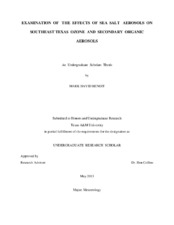| dc.description.abstract | Despite decades of study, we still do not fully understand aerosols and their interactions among gases or other aerosols in the atmosphere. Among their impacts, they influence radiative transfer in the atmosphere and contribute to cloud formation. There are many different types of aerosols, including dust particles, soot particles, and microscopic particles containing inorganic compounds such as sulfates. Most of these particles have natural origins, but many are anthropogenic. The eventual purpose of this research is to examine sea salt aerosols and their impact on polluted environments. Sea salt aerosols act as Cloud Condensation Nuclei (CCN) as well as providing a surface for heterogeneous reactions. Such reactions have implications for trace gases such as ozone, reactive nitrogen, mercury, and sulfur containing compounds. Urban areas are most impacted by these trace gases, which is a concern because ozone especially affects the health of citizens. Experiments have three basic parts. First we generate mono-disperse
3
aerosols. That aerosol is then injected into the aerosol chambers with sea salt aerosols and prescribed concentrations of trace gases to characterize relevant interactions. However, those chambers are still under construction and not used during my study. The processed aerosols are then analyzed with a tandem differential mobility analyzer (TDMA) and other equipment. Different concentrations of sea salt aerosols, Cl, NOx, and other gases were planned to be introduced during the experiments. Concentrations of other gases and intensity of solar radiation would mimic those outside. Because these reactions have proved to increase localized concentrations of ozone in other work, this could have important implications. Future work will be designed to find study these interactions. This is important because the EPA has considered tightening the standards for both ozone and particulate matter. Industries would then need to reduce emissions or move farther from current sources of Cl or NOx pollution. | en |


